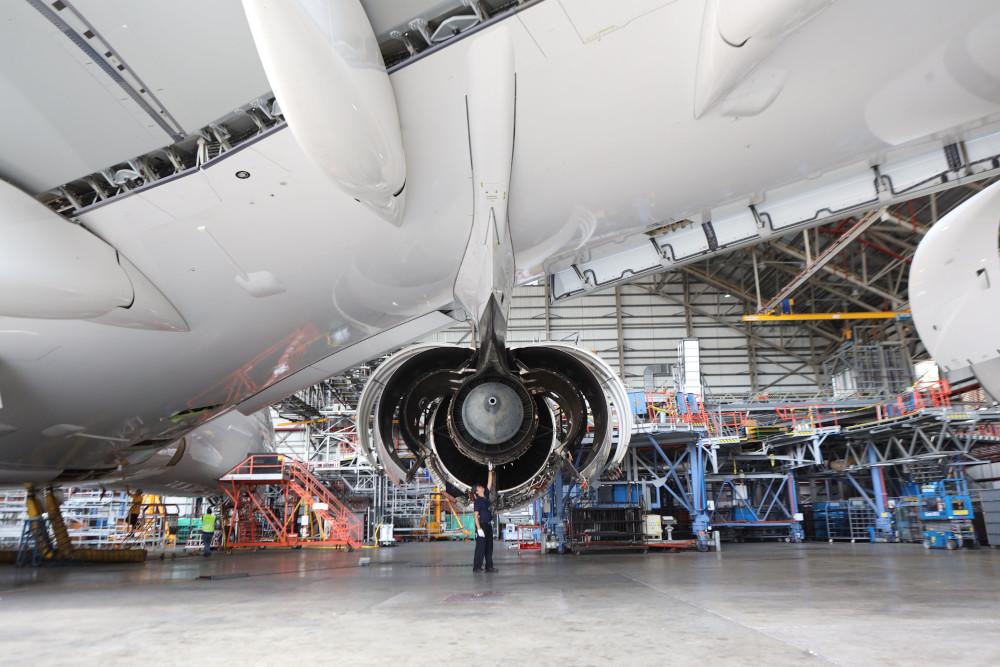Bullish Lufthansa Technik Plans Future Investments, Eyes More Engine Capacity

Following an 18% year-on-year revenue increase in 2023, German MRO giant Lufthansa Technik is planning long-term growth through fresh investment over the next four years along with potential acquisitions while growing its network capacity.
In a virtual press conference held March 12, Hamburg-headquartered Lufthansa Technik (LHT) posted revenues of €6.5 billion ($7 billion), up from €5.5 billion ($6 billion) in 2022. Adjusted earnings before interest, taxes, depreciation, and amortization (EBITDA) increased 13% in 2023 compared to the previous year, totaling €628 million ($686 million).
Soeren Stark, CEO of LHT, says the company’s strong results for last year were delivered against a backdrop of “dramatic” material cost increases. It secured around 1,000 new contracts in 2023 and a total of 27 new customers with a collective value of €8 billion ($8.7 billion).
Also in 2023, speculation about the future of LHT’s ownership was clarified after its Lufthansa Group parent decided against divesting a stake in the MRO to an outside investor. With its ownership confirmed long-term, Stark revealed that LHT plans to invest €1.2 billion ($1.3 billion) over the next four years as part of its ‘Ambition 2030’ growth strategy.
In terms of long-term financial targets, LHT is looking to increase its revenues by more than €10 billion ($10.9 billion) with a double-digit earnings margin by 2030. Ultimately, Stark says its goal is to generate earnings of more than €1 billion ($1.09 billion).
LHT plans to grow capacity across its network to accommodate greater maintenance demand. It plans to do this by establishing a new component repair facility by 2027. The location will likely be in the southwest of Europe and will also include capability for engine component repairs. A decision on the location is likely to be made over the next few months.
Outside of Europe, the repair specialist is also considering growth through acquisitions in North America and Asia-Pacific and this could progress this year as LHT looks to grow “inorganically.”
“I would assume it’s only a question of months rather than years that we will find a suitable target not only in the Americas but also in Asia-Pacific,” says Stark.
Stark says growth in the engine maintenance segment, which accounts for about 50% of the commercial aftermarket up to 2030, will be “of the essence” as new-generation models replace legacy ones. He says LHT is looking to prioritize growth particularly for Leap 1A and -1B engine types, with the program expected to hold the largest share of the new-generation narrowbody engine segment.
LHT is seeing ongoing challenges related to the Leap’s competitor engine, the Pratt & Whitney geared turbofan, at its Hamburg engine shop and in its Poland-based EME Aero joint venture. Throughput times on engine overhauls remain at around 150 days—originally meant to be half of that—with the MRO provider citing parts shortages from the engine manufacturer.
Stark also noted an unexpected upturn for Airbus A380 maintenance. The aircraft type has been decreasing in volume at operators after production ceased on the program in 2019, but Stark says LHT has won several base maintenance contracts and landing gear repair agreements with the carriers such as British Airways, Korean Air and its Lufthansa airline affiliate.
“Given production difficulties, I think we will see the A380 for another five, six, maybe seven years and then it will be down to the carriers to see which alternatives are available to phase out the A380,” he says of the superjumbo’s future fleet prospects.
However, Stark is not optimistic about a near-term fix for ongoing supply chain issues that have dogged the industry since the COVID-19 pandemic four years ago. “There’s not much we can do about the situation—we’ve tried to build up buffers by increasing material stock, but this can only be done if this is available on the market,” he says.
Staff shortages are also expected to continue to play a role in the lagging supply chain. The LHT CEO notes a high churn of staff at its LHT Philippines location due to technicians being poached by Middle Eastern and North Asian countries, while in North America it is still reeling from a workforce exodus during the pandemic.





